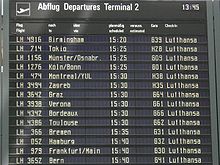Flight Information Display System

A Flight Information Display System ( FIDS ) is a near-real-time software system which an airport serves to supply all clients with current flight data and also to update them in an event-controlled manner. In this context, a client can be a monitor in the public or staff area, a case sheet or LCD panel, any Internet / Intranet client or theoretically any other technical device for displaying flight data. A FIDS is normally designed generically, so that the effort to connect new display clients is limited and i. d. Usually limited to the protocol-specific characteristics.
The flight data changes (status changes, gate , belt and counter assignments, estimated time, etc.) processed by a FIDS can have any source and / or cause. They can be entered directly by an operator, but they can just as easily be generated automatically by the system (due to different time parameters). Connections to external systems ( CUTE , SITA etc.) can also cause status changes and are processed accordingly by the FIDS.
The data center of a FIDS is the current flight, which is clearly identified by type (A / D), scheduled time (STM) and flight number. A well-thought-out system also takes code- sharing flights and rotation links into account . One speaks of code sharing when several flight numbers relate to a physical flight (e.g. LH 765 and UA 621 to JFK are handled by a Lufthansa machine). A rotation is the combination of an arrival and a departure flight number, which refer to the same physical machine. A Lufthansa Airbus A321, for example, arrives as LH301 from Hamburg at Gate A13 and flies back to Hamburg 45 minutes later as LH302.
A well thought-out FIDS enables airports, airlines , aircraft types , flight statuses and resources such as gates, counters, baggage belts and parking stands to be dynamically adjusted. A central part of the system's functionality is also the continuous status monitoring of the connected display peripherals (public monitors, display boards, etc.). Irregularities are logged by the system. Modern systems also send e-mails / SMS to the responsible system administrator and make it possible, for example, to control the system via mobile phone.